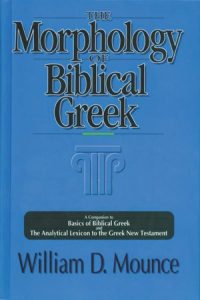How to use MBG:
Let’s analyze the following forms of the verb γινομαι:
First, you need to find the stem of this verb. To do this, look up γινομαι in the index of MBG (see the index at the very back of the book). Note the which is given to this verb v-1c(2).
Now find that code in the body of the book (see page 265). This page gives us the definition of these kind of verbs. The definition that corresponds to this is, “Verbal roots ending in a liquid/nasal“. In Greek, this means the letters μ or ν. From this, we can easily deduce that the stem of γινομαι is γιν. Note: MBG provides the first person singular form of each verb in each tense. It is very important to know for what tense each of these columns stands. Starting from the left, the columns show you the lexical form of the present active (φερω), future active (οισω), aorist active (ηγεγχα), perfect active (ενηνοχα), perfect middle/passive (ενηνεγμαι), aorist passive (ηνεχθην).

Now that we know the stem, we can move to building γινομαι into a present, aorist, and perfect tense; first, singular form. We know we need first singular forms because the forms we are asked to build are “I become”, “I became”, and “I have become” all of which are first singular forms.
I become
For I become, we want to build a present tense form, so let’s turn to the chapter for present middle/passive forms (BBG chp 18). Note: even though this verb is active in meaning, it is passive in spelling; i.e. this verb is deponent. In paragraph 18.6, we are given the building blocks for these verbs. These building blocks are:
| Present tense stem | Connecting vowel | Primary passive personal endings |
| From the previous step, we know the stem is γιν. | From BBG 18.7, I can see that the connecting vowel for the first singular is omicron. | Also from 18.7, I can see that the ending for a first person, singular verb is -μαι. |
| γιν | ο | μαι |
γινομαι = I become
I became
The only difference here is the tense. In Greek, the aorist tense is the default tense for verbs showing past action. To find these forms, I turn to chapter 22 in BBG. The building blocks of these verbs are:
| Augment | Aorist active tense stem | Connecting vowel | Secondary middle/passive personal endings |
| An augment is almost always a simple epsilon prefix. | From the previous step, we know the stem is γεν. | From BBG 22.15, I can see that the connecting vowel for the first singular is omicron. | Also from 22.15, I can see that the ending for a first person, singular verb is -μην. |
| ε | γεν | ο | μην |
εγενομην= I became
I have become
The “have” is your clue that this is the perfect tense. You will find the building blocks for this verb in BBG chp 25. The building blocks of these verbs are:
| Reduplication | Perfect active tense stem | Tense formative | Primary active personal endings |
| If you are wondering what this is, study this. | From MBG, we know the stem is -γον. If you are wondering about this, study BBG 25.14. | From BBG 25.4, I can see that the tense formative is κα. However, because this is a second perfect, the tense formative is simply α (BBG 25.14). | Also from 25.4, I can see that there is no ending for a first person, singular form. |
| γε | γον | α | – |
γεγονα = I have become

